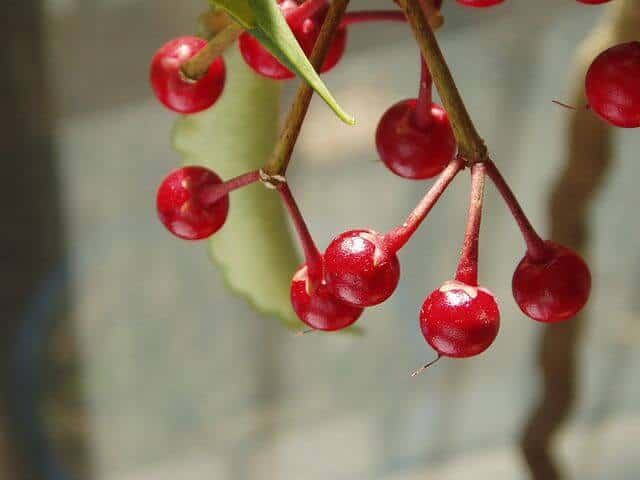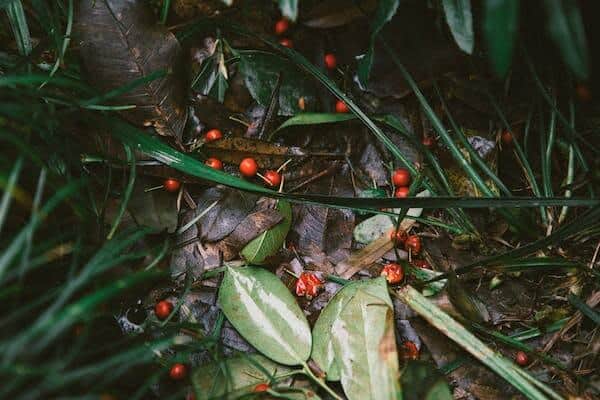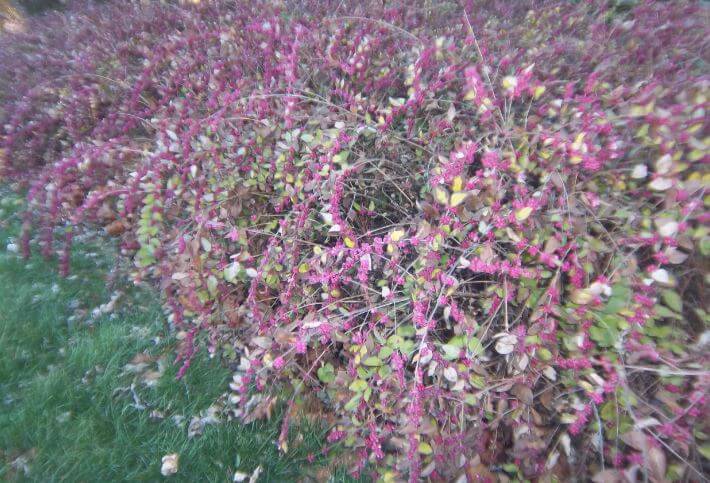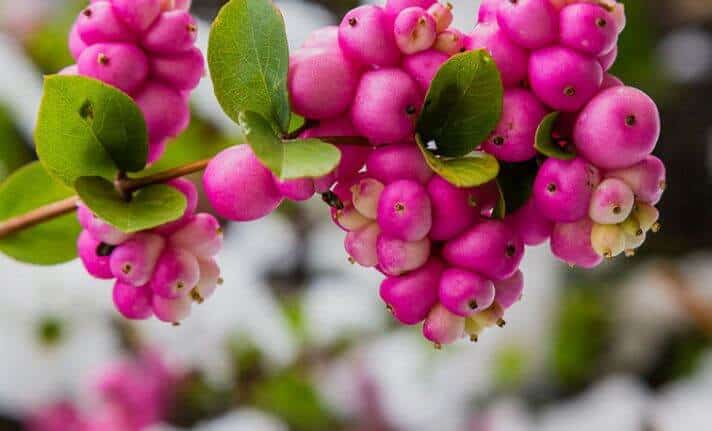Last Updated on January 7, 2023 by a Friendly Gardener
A tropical native, Coral berry is popularly referred to as the Christmas berry thanks to its bright-colored berries. This plant can be cultivated outdoors in USDA hardy zones 3a through 7b and may be found as a tree, bush, shrub, or ground cover. Botanically known as Ardisia crenata, it belongs to the Primulaceae family with other popular names such as the spice berry or marl berry.
The Ardisia genus hosts more than 700 species that are found in a multitude of zones globally. North and South America, Asia, and Australia all host this plant. Among the many species of the Ardisia genus, the Ardisia crenata is considered to be invasive in the US when grown outdoors in areas like Texas or Florida. Other common Ardisia species include the Ardisia elliptica, Ardisia escallonioides, Ardisia japonica, and Ardisia solanacea.
The Coral Berry Bush is a popular houseplant that produces glossy oval-shaped dark green foliage with serrated edges along with bright red berries throughout the fall and winter adding a delightful burst of color to home décor. Berries are not limited to red but may appear in off-white or coral hues as well. This evergreen plant does well in climates with temperatures that remain above 50°F. It is easy to grow, explaining why it performs so well as a houseplant.
Coral Berry Plant Care

Coral berry plants are pretty independent when it comes to care, but some basic environmental conditions contribute to a happy plant.
Soil

The Coralberry plant loves a well-draining soil bed. It is very adaptable to various soil types, including clay-like soil, but ideally, a soil mix offering a combination of moisture retention and drainage is best. Amend potting soil with worm castings or compost to provide nutrients along with several fists of peat moss or coconut coir. Your plant’s soil bed should guarantee good airflow and drainage with no compaction. The Coral Berry prefers soil pH to be just a bit acidic although it will manage with a neutral or slightly alkaline soil. The coral berry shrub can thrive in a wide pH range measuring from 3.5 to 9.
Light
Bright, indirect light is appreciated, so partial shade should be the general rule. A few tall-growing species when cultivated outside can tolerate direct sunlight in their native environments, but as a rule, try to provide generous indirect filtered light. This is not a low-light houseplant, so if your home does not have access to bright natural light, compensate with a grow light where necessary.
Water
Soil needs to be kept evenly moist for this houseplant. Overwatering can lead to root rot while underwatering can lead to crispy foliage. Begin with a weekly watering but check your plant daily to verify how quickly the soil bed dries out in your home environment. If it dries out quickly, water your plant more frequently.
Never leave this plant in a dish with standing water, as the soil can become waterlogged or develop fungal infections.
Humidity

Depending on your home’s humidity level, watering more often may not be necessary. The Coralberry will absorb some water from the air. Average home humidity should be fine. If the environmental air is arid, consider a water-filled receptacle nearby to improve humidity in the area of the plant.
Temperature
The Coral Berry thrives in indoor temperatures that measure between 60° and 90°F. with 60° to 80° being ideal. It will suffer when kept in temperatures below 45°F and need protection when exposed to extreme heat.
Feeding

Even without fertilizer, the Coral Berry will survive and grow. To encourage your plant, provide a monthly application of a balanced liquid fertilizer, or slow-release pellets during the growing season in the spring and summer months. Interrupt fertilization in the fall and winter.
Potting and Repotting a Coral Berry Plant
Check out your plant at the beginning of spring to verify if it is root bound. When root bound, it’s time to repot. If not, wait another year. When repotting, select a new container that is one size larger. To repot, gently remove the plant from its old container and remove old soil from the root system. Repot using fresh, well-draining soil. Cover plant roots to the same height as in their original container. Water thoroughly, allowing excess water to drain off. Add old soil to your composting pile or blend in compost to use anew.
Pruning Your Coral Berry Plant
Pruning is done to maintain the desired shape of your plant. It should be performed at the end of winter or in early spring before new growth develops. Be aware that the Coral Berry bush is a slow-growing plant, so it may not require a great deal of trimming.
You will also want to decide if you want berries when the flowers are spent. If you enjoy the burst of winter color, allow your plant to develop the brightly-hued characteristic fruits. If you are considering transplanting it outdoors, berries are the key to its invasiveness, so snip off flowers before the berries appear.
Coral Berry Propagation

These plants can be propagated using seeds, air layering, or plant cuttings. When opting to use seeds, you can plant a berry as each berry contains multiple seeds. The berry exterior will decompose, fertilizing seeds within the soil. Once germination takes place, thin them down to a single plant per pot.
To propagate using cuttings, using sterilized garden shears, snip a stem that is six to eight inches in length. Remove all foliage from the cutting except for the very top leaves. Dip the cut end in root hormone to improve your chances of success and insert this end in a growing medium. Cut ends can also be placed in water for root development and then transplanted into the soil once they have formed.
Air layering is a bit more complicated, but if you’re up to a challenge it is an important tool in plant propagation. You’ll need to cut a section from the outer layer of the plant’s stem without cutting through entirely. Apply rooting hormone to the cut and then wrap the wound in sphagnum peat moss for moisture retention purposes. Wrap the moss covering with plastic wrap and secure with a string if necessary. Wait for roots to develop. Once the roots have developed you can cut the stem off with the roots and transplant it into another container.
Coral Berry Problems
The Coral Berry bush is relatively free of problems, nonetheless, watch for these so you can intervene early.
Watering Issues
Excessive watering can lead to root rot. This plant should never be left to stand in soggy soil. Too little water will cause foliage to suffer, so be aware if the soil moisture is evaporating too quickly and make adjustments accordingly.
Coral Berry Bush Pests

Coral Berry plants are evidently not particularly tasty for insects as they suffer pest infestations much less than other houseplants. You may find mealy bugs occasionally on your Coral Berry shrub. Remove these pests manually and spray the foliage with organic Neem oil to keep them at bay.
Coral Berry Plant Disease
Fungal root rot is the greatest threat to your plant. Many fungi thrive in wet soil and will attack the roots. If your soil bed is not well-draining, your plant is at risk. Root rot will set in, causing the plant to turn yellow and eventually wilt. Stems will become mushy and emanate an odor. The best defense is to prevent soil from becoming soggy.
In Conclusion
When cultivated outdoors, this plant can be highly invasive, but it offers a delightful burst of color during long winter days when grown as a houseplant in an indoor garden.

